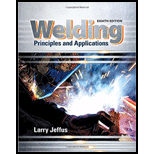
Bundle: Welding: Principles and Applications, 8th + MindTap Welding, 4 terms (24 months) Printed Access Card
8th Edition
ISBN: 9781337219426
Author: Larry Jeffus
Publisher: Cengage Learning
expand_more
expand_more
format_list_bulleted
Concept explainers
Textbook Question
Chapter 5, Problem 13R
Why must the weld crater be cleaned before starting a new electrode?
Expert Solution & Answer
Want to see the full answer?
Check out a sample textbook solution
Students have asked these similar questions
16.1. The cart has mass M and is filled with water that has a mass mo. If a pump ejects water
through a nozzle having a cross-sectional area A at a constant rate of vo relative to the cart,
determine the velocity of the cart as a function of time. What is the maximum speed
developed by the cart assuming all the water can be pumped out? Assume the frictional
resistance to forward motion is F and the density of water is p.
16.2 A block of mass 10 kg is subjected to a force F(t) at an angle 30° from the horizontal that is
at a constant 12 N for 3 seconds and is suddenly increased to 18 N afterwards. A constant 1 N force
acts on the block as shown as well. The static and kinetic friction coefficients between the block
and the ground is 0.15 and 0.10, respectively. Determine the magnitude and direction of the
velocity of the block after 5 seconds.
Ms=0.15
Mk = 0.10
F(t) [N]
F(t)
18
1 N
30°
m = 10 kg
12
t [s]
3
No chatgpt
Chapter 5 Solutions
Bundle: Welding: Principles and Applications, 8th + MindTap Welding, 4 terms (24 months) Printed Access Card
Ch. 5 - List some applications that use low-pressure...Ch. 5 - List some applications that use medium-pressure...Ch. 5 - List some applications that use high-pressure...Ch. 5 - Describe the differences between pipe and tubing.Ch. 5 - What are the advantages of welded piping systems...Ch. 5 - Why must the ends of pipe be beveled before being...Ch. 5 - How can the ends of a pipe be beveled?Ch. 5 - Why is the end of a pipe beveled at a 371/2 angle?Ch. 5 - What causes root suck-back or a concave root face?Ch. 5 - Why are arc strikes outside the welding zone...
Ch. 5 - What are the purposes of backing rings?Ch. 5 - What is the purpose of a hot pass?Ch. 5 - Why must the weld crater be cleaned before...Ch. 5 - What is the maximum width of the cover pass? Why?Ch. 5 - When is the 1G welding position used?Ch. 5 - What can make welding in the 2G vertical fixed...Ch. 5 - What supports the welds on a 2G pipe joint?Ch. 5 - On 5G welds, what usually determines the direction...Ch. 5 - What angle is the pipe at in the 6G position?Ch. 5 - In addition to continuously changing the weld...
Knowledge Booster
Learn more about
Need a deep-dive on the concept behind this application? Look no further. Learn more about this topic, mechanical-engineering and related others by exploring similar questions and additional content below.Similar questions
- I need expert handwritten solutions, don't use Artificial intelligencearrow_forwardConsider the combined gas-steam power cycle. The topping cycle is a gas-turbine cycle that has a pressure ratio of 8. Air enters the compressor at 300 K and the turbine at 1300 K. The isentropic efficiency of the compressor is 80%, and that of the gas turbine is 85%. The bottoming cycle is a simple Rankine cycle operating between the pressure limits of 7 MPa and 5 kPa. Steam is heated in a heat exchanger by the exhaust gases to a temperature of 500°C and the isentropic efficiency of the turbine is 90 %. The exhaust gases leave the heat exchanger at 450 K. Considering the mass flow rate steam as 1 kg/s, determine: A) Net power, B) Total input heat, C) Total entropy generation, D) Energy efficiency, E) Exergy efficiency, F) T-s diagram Solve by EES Compressor Air -③ in Exhaust gases Pump Combustion chamber Gas turbine Gas cycle Heat exchanger Condenser Steam Steam turbine cyclearrow_forwardI need expert solution s to this question, don't use Artificial intelligencearrow_forward
- I need solutions to this questions Don't use Artificial intelligencearrow_forwardPlease consider the following closed-loop Multiple-Input Multiple-Output (MIMO) control system: R₁(s) and R2(s) are the reference signals (or inputs), • G₁(s) (where i = 1,2,3,4,5) are the plant transfer functions, • C₁(s) and C2(s) are the responses (or system outputs), • All of them are in Laplace domain. R2 + R₁ + + G₂(s) G3(S) Tasks: G5(s) G4(s) + G₁(s) می a) Please derive the transfer function between C₁ (s) and R₂(s) (i.e., find R₂(s) (10 marks) (10 marks) b) Please derive the transfer function between C₂(s) and R₁(s) (i.e., find C2 (s)). R₁(s) Hint: Please carefully analyse how the signals interact with the plants G₁(s) and find all paths fromarrow_forwardMột thanh dài L = 2,5 m được nối bằng chốt với một con lăn ở A. Con lăn chuyển động dọc theo một đường ray nằm ngang như hình vẽ với VA 5 m/s. Xác định vận tốc của điểm C (trung điểm của thanh AB) = tại thời điểm 0 = 33° và O = 0.4 rad/s. A. v = (-5.42+0.272})(m/s) C. v = (5.421+0.272})(m/s) B. v =(0.272i+5.42j)(ms) D. (5.42-0.272)(m/s) = C Barrow_forward
arrow_back_ios
SEE MORE QUESTIONS
arrow_forward_ios
Recommended textbooks for you
 Welding: Principles and Applications (MindTap Cou...Mechanical EngineeringISBN:9781305494695Author:Larry JeffusPublisher:Cengage Learning
Welding: Principles and Applications (MindTap Cou...Mechanical EngineeringISBN:9781305494695Author:Larry JeffusPublisher:Cengage Learning

Welding: Principles and Applications (MindTap Cou...
Mechanical Engineering
ISBN:9781305494695
Author:Larry Jeffus
Publisher:Cengage Learning
Metal Joining Process-Welding, Brazing and Soldering; Author: Toc H Kochi;https://www.youtube.com/watch?v=PPT5_fDSzGY;License: Standard YouTube License, CC-BY